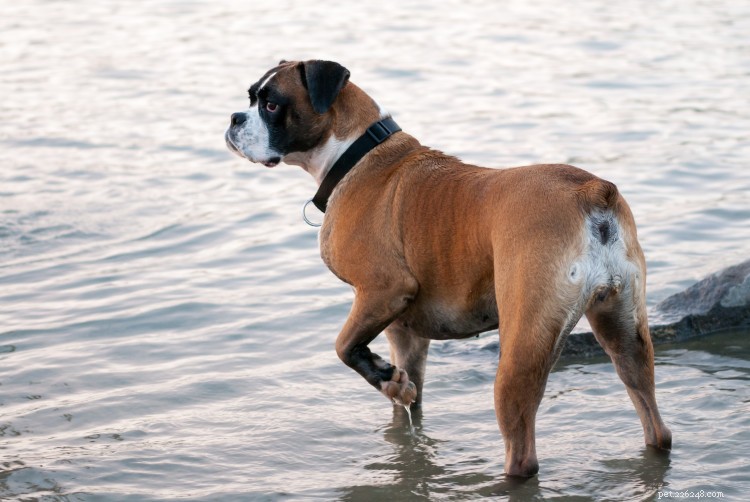Les boxeurs sont des chiens qui aiment s'amuser, sont fidèles et alertes avec une carrure athlétique. Élevé à l'origine pour la chasse au gros gibier, le Boxer est considéré comme un chien de taille moyenne à grande. Ils sont excellents avec les enfants et les chiens de garde astucieux. Aujourd'hui, ils sont connus pour être l'une des dix races de chiens les plus populaires d'Amérique et avoir la langue la plus longue parmi les chiens. Si vous avez un chiot Boxer, vous vous demandez peut-être quelle taille peut atteindre un Boxer et comment puis-je savoir que mon Boxer a fini de grandir ?
Tout ce que vous devez savoir sur la croissance de Boxer :
- Tableau de croissance et de poids du boxeur masculin
- Tableau de croissance et de poids des boxeuses
- À quel âge un Boxer atteint-il sa pleine maturité ?
- Quelle est la taille d'un Boxer de 6 mois ?
- Combien de plus grand mon boxer va-t-il gagner ?
- Quelle est la taille d'un Boxer adulte ?
- Comment puis-je m'assurer que mon Boxer est en bonne santé ?
Tableau de croissance et de poids du boxeur
Les chiffres suivants sont tous des estimations pour vous aider à estimer la taille de votre Boxer à certains âges. Ce sont des estimations, alors ne vous inquiétez pas si votre Boxer est légèrement en retard ou en avance sur ces chiffres. Continuez simplement à emmener votre Boxer à des rendez-vous vétérinaires réguliers pour vous assurer qu'il est heureux et en bonne santé.
Conseil de pro : Vous souhaitez vous faire rembourser les frais vétérinaires de votre chien ? Comparez les options d'assurance maladie Boxer et inscrivez-vous pour économiser gros sur les frais vétérinaires (et la tranquillité d'esprit).
Tableau de croissance et de poids du boxeur masculin
| Âge | Poids |
|---|
| 1 mois | 5,5 à 9 lbs |
| 2 mois | 16 - 20 livres |
| 3 mois | 22 - 26 livres |
| 4 mois | 30 - 35 livres |
| 5 mois | 35 - 41 livres |
| 6 mois | 41 - 48 livres |
| 7 mois | 48 - 55 livres |
| 8 mois | 50 - 57 livres |
| 9 mois | 52 - 61 livres |
| 10 mois | 55 - 63 livres |
| 11 mois | 57 - 66 livres |
| 1 an | 57 - 68 livres |
| 1,5 ans | 60 - 70 livres |
| 2 ans | 60 - 70 livres |
Tableau de croissance et de poids des boxeuses
| Âge | Poids |
|---|
| 1 mois | 4,5 à 8 lbs |
| 2 mois | 11 - 17 livres |
| 3 mois | 22 - 26 livres |
| 4 mois | 28 - 30 livres |
| 5 mois | 33 - 37 livres |
| 6 mois | 39 - 44 livres |
| 7 mois | 44 - 50 livres |
| 8 mois | 50 - 52 livres |
| 9 mois | 52 - 59 livres |
| 10 mois | 52 - 59 livres |
| 11 mois | 52 - 59 livres |
| 1 an | 52 - 61 livres |
| 1,5 ans | 55 - 63 livres |
| 2 ans | 55 - 65 livres |
À quel âge un Boxer est-il adulte ?
En tant que race de chien de taille moyenne à grande, les Boxers ont besoin de plus de temps pour se remplir et atteindre leur pleine taille que les races de chiens plus petites. En règle générale, attendez-vous à ce que votre Boxer grandisse jusqu'à l'âge de 18 à 24 mois. Gardez à l'esprit que cette plage est une estimation, il y a donc toujours des exceptions.
 (Source de l'image :Canva)
(Source de l'image :Canva)
Quelle doit être la taille d'un Boxer de 6 mois ?
A 6-month-old male Boxer should weigh around 41 to 48 pounds, while a 6-month-old female Boxer will weigh about 39 to 44 pounds.
According to Care.com, puppies reach about 75% of their full height at six months of age. For a male Boxer puppy, this would be around 17 to 19 inches tall. 6-month-old Female Boxer puppies will be approximately 16 to 18 inches tall.
Conseil de pro : Check out this downloadable new puppy checklist covering topics like vaccination schedules, setting up the home for a new puppy, teething, veterinary visits, and more!
How much bigger will my Boxer get?
There are several ways to estimate how much bigger your Boxer will grow.
If your Boxer is less than two years old , they are likely still growing. Some Boxers stop growing closer to 18 months, but many Boxers will continue to fill out in weight and body size until they are two years old.
Another possible way to estimate their size is to contact your Boxer’s breeder . Many breeders can give you a more accurate estimate based on previous litters and their parents’ exact height and weight. A puppy will rarely be larger than either parent, so this can give you a clearer idea of their maximum size.
Lastly, take a look at your Boxer’s paws . Do their paws look oversized compared to their legs and the rest of their body? This is a strong sign that your Boxer is still growing and filling out!
What is the size of a full-grown Boxer?
According to the American Kennel Club Official Boxer Standards, a full-grown male Boxer will stand around 23 to 25 inches tall, while a female Boxer will stand about 21.5 to 23.5 inches tall.A fully grown male Boxer will weigh around 60 to 70 pounds, with their female counterpart will weigh about 55 to 65 pounds.
 (Image Source:Pexels)
(Image Source:Pexels)
How do I make sure my Boxer is healthy?
As with many things, prevention is always better than treatment. Taking your Boxer to regular veterinary appointments is one of the best things you can do for their health, along with consistent love and care at home.
One of the best things you can do at home is brush your dog's teeth regularly to help prevent painful periodontal disease and avoid pricey dental treatments in the future. Periodontal disease can cause bad breath and oral pain for your pup and may require your Boxer to have a dental cleaning or tooth extractions under anesthesia at some point in their lives if not attended to at home.
Keeping your Boxer at a healthy weight is crucial for their longevity, overall health, and happiness. If your Boxer is overweight, talk to your veterinarian to develop a weight loss strategy so that you can get them back on track. Consult with your veterinarian about the ideal food and exercise for your Boxer.
Like all dogs, Boxers have certain conditions that they are prone to. Boxers are a purebred dog breed prone to heart problems , like cardiomyopathy, heart valve narrowing, and congenital heart defects. Boxers are also known to have more breathing issues due to their brachycephalic syndrome , which gives them their classic “squished nose” appearance, but also gives them shorter airways in their nose making it harder to breathe at times. Brachycephalic syndrome increases their risk of respiratory distress, allergies, heatstroke, and sinus problems.
While we as pet parents know our dogs well, your veterinarian is well trained and experienced in screening and monitoring your pup’s health and growth. Regular veterinarian appointments are crucial in finding and treating illness early to give your Boxer the healthiest and longest life possible.
Unfortunately, veterinary bills can be costly with many treatments for emergencies and illnesses, such as heart problems, being thousands of dollars to treat.
When surveyed, 49.7% of pet parents said they would be unable to cover a $5,000 vet bill, and another 30.86% of pet parents would need to find financing options to cover this expense. The financial safety net provided by pet insurance is why pet insurance is worth it for many pet parents. When the worst happens, whether that’s an accident, injury, or diagnosis, having peace of mind that you can financially handle the situation because the pet insurance you got when your Boxer puppy was young and healthy will cover up to 90% of the cost of their treatment, is the best gift you can give yourself and your dog.
Final Considerations
Your veterinarian is an excellent resource in determining your Boxer’s ideal weight and lifestyle. Consult with them today to assess your Boxer’s current health and what can be improved.
Keep in mind that even healthy behaviors, like exercise, can be overdone. Consult with your veterinarian about how much exercise is prudent. Medium to large-sized dogs that are still growing may suffer from joint damage if they are overexercised. Make a plan with your veterinarian today to provide your Boxer with the ideal amount of exercise to keep them lean, healthy, and happy.
Boxer puppies grow into strong and sturdy adults that make fun-loving, often silly companions, and fierce protectors. Give yourself peace of mind today when you pick from the top Boxer insurance providers using Pawlicy Advisor, a personalized pet insurance comparison tool created to find the best plan specific to your dog’s needs.
Pawlicy Advisor’s recommendations can save you over 83% on pet insurance costs over your pet’s lifespan and provide you with the comfort of having a backup plan should the worst happen.